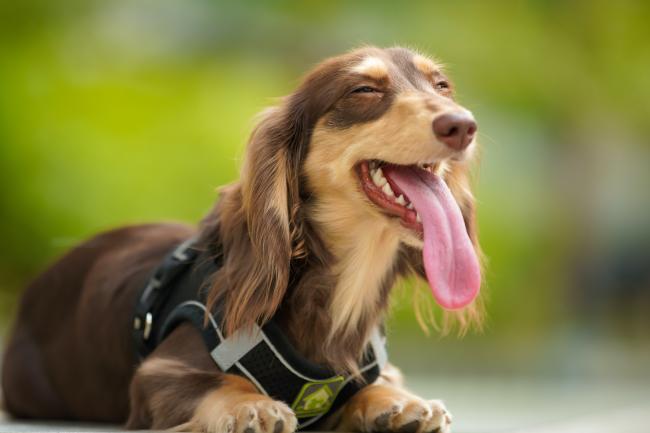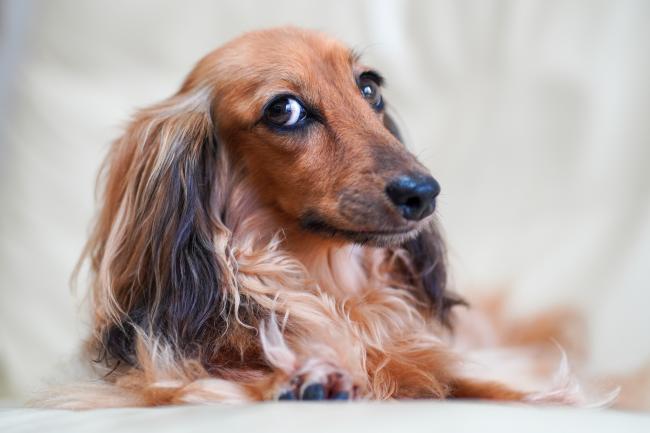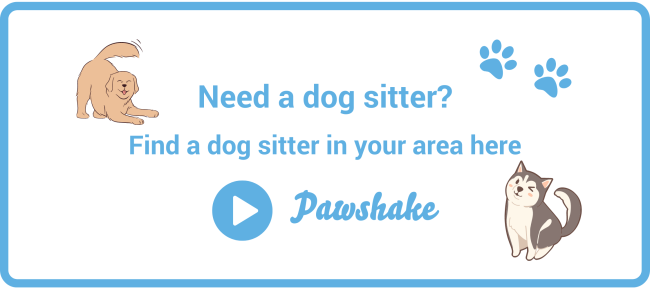Dachshund aka Wiener or Sausage Dog: Breed Spotlight

Dachshund Facts
- Breed name: Dachshund
- Classification: Hound
- Size: Small to Medium
- Coat: Short, long, or wire-haired
- Colour: Various, including red, black, chocolate, and cream
- Personality: Clever, lively, affectionate
- Family-friendly: Yes
- Friendly with other pets: Yes
Dachshund Background
The Dachshund, also known as the "Sausage Dog," is a unique breed with a long body and short legs. This article covers all you need to know about Dachshunds, including their origin, special traits, and care needs.
Origin and History
The Dachshund breed goes back to 17th-century Germany. In the 1600s, people wanted a hunting dog that could find and catch animals in hard-to-reach places. This led to the intentional breeding of a small dog with a long body and short legs, creating the Dachshund.
The breed's name, "Dachshund," is a compound of the German words "Dachs" (badger) and "Hund" (dog), reflecting its historical role as a "badger dog." Over the 18th and 19th centuries, selective breeding refined Dachshunds, enhancing their hunting prowess.
Today, people cherish Dachshunds as family pets, therapy dogs, and participants in canine sports, showcasing their tenacity and intelligence. The Dachshund's rich history has shaped them into beloved and iconic canine companions worldwide.

Physical Appearance of the Dachshund
Dachshunds exhibit an array of coat varieties. The short-haired Dachshund boasts a sleek and low-maintenance coat, showcasing the breed's original hunting lineage. The long-haired Dachshund are elegant with flowing, silky strands, and the wire haired Dachshunds stand out with their rugged and wiry coats.
Beneath their varied coats, Dachshunds all share a common thread—a compact yet muscular build that defines their silhouette. Elongated bodies and short legs are the hallmarks of the breed. These features serve as both a nod to their hunting heritage and are a distinctive feature that captures the eye.
The eyes of Dachshunds become windows to their souls, conveying a spectrum of emotions from curiosity to unwavering loyalty. Paired with their characteristically droopy ears, these facial features enhance the overall charisma of the breed.
The wide range of Dachshund appearances are a blend of aesthetics and personality that makes them truly unique.
Dachshund Behaviour and Temperament
People know Dachshunds for their spirited nature and often describe them as lively and clever. Despite their small size, they possess a bold personality. Dachshunds are affectionate and often form strong bonds with their human companions. Their intelligence makes them responsive to training, but their independent streak may present some challenges.

Training Dachshunds
Training Dachshunds is highly rewarding. Using positive reinforcement methods works well with their perceptive nature. Using challenges to keep them engaged allows them to show off their problem-solving skills.
Dachshunds do have a strong instinct to hunt, which needs careful training as a result of their focused prey drive. Therefore it is important to intervene early, turning the instinct into a positive aspect rather than a negative.
In the realm of training - timing and consistency are key. By developing a consistent, rewards-based training routine, you will tap into the capabilities that make Dachshunds unique.
Living with a Dachshund Dog
Welcoming a Dachshund into your home means embracing their spirited nature. These adaptable hounds integrate into a variety of living situations. Their small size allows them to flourish in a wide range of settings. You'll find them happy and content from the snug confines of an apartment to to the spacious surroundings of a house and yard.
That being said, the joyous digging tendencies of Dachshunds may prompt a re-think of your approach to landscaping.
Dachshunds, celebrated for their affectionate companionship, shine in interactions with children. Their small stature and playful demeanour add a delightful dimension to family dynamics. But because they are small, they need careful supervision to avoid accidents while playing.
The playful charm and unwavering loyalty of Dachshunds that make them exceptional additions to loving households. Living with a Dachshund becomes a rewarding journey filled with enriching experiences and the boundless love they generously offer.
Dachshund Health
Dachshunds are generally robust dogs. However, their unique body structure does make them susceptible to specific health issues.
Intervertebral Disc Disease (IVDD):
One of the primary health concerns for Dachshunds is Intervertebral Disc Disease (IVDD). Given their elongated spinal structure, these dogs are more prone to disc herniation and spinal issues. IVDD can manifest as back pain, hind limb weakness, or even paralysis.
Owners should take precautions to ensure the well-being of their pets. To stay safe, use ramps instead of stairs & avoid excessive jumping. Additionally, ensure a balanced diet to maintain a healthy weight.
Obesity:
Dachshunds' affection for food and their unique physique drive their predisposition to obesity. Excess weight can increase the risk of back problems and strain their joints. It's important for owners to regulate their Dachshund's diet, ensuring portion control and choosing high-quality, nutritionally balanced food. Incorporating regular exercise tailored to their specific needs is vital in preventing and managing obesity.
Dental Issues:
As a result of their small size and specific jaw structure, Dachshunds may be prone to dental problems. Regular teeth cleaning, appropriate chew toys, and dental treats can aid in maintaining good oral hygiene. Owners should also schedule professional dental cleanings as recommended by their vet to prevent disease.
Breed-Specific Considerations:
Understanding Dachshund-specific needs is crucial for responsible ownership. Their elongated bodies benefit from supportive beds and proper spinal alignment during rest. Owners should pick toys and activities that suit their body, avoiding ones that strain their backs.
Breeding Dachshunds responsibly is important for their future health and vitality. It involves caring for the breed's well-being.

Dachshund Grooming
Grooming a Dachshund involves specific considerations based on their coat type. Here are some grooming tips:
- Short-Haired Dachshunds: Brush their coat weekly to reduce shedding and promote a shiny coat.
- Long-Haired Dachshunds: Regular brushing is essential to prevent mats and tangles.
- Wire-Haired Dachshunds: Their unique coat requires hand-stripping or professional grooming to maintain its texture.
Regular ear checks, teeth brushing, and nail trims are integral parts of Dachshund grooming routines. Early introduction to grooming practices helps them become accustomed to the process.
Training sessions help dogs bond and associate grooming with positive experiences, creating a great opportunity for connection. Establishing a consistent grooming schedule from an early age ensures that Dachshunds remain comfortable with the process.
Dachshunds, with their charming appearance and lively personality, make delightful companions. To have a happy relationship with your Sausage Dog, it is important to understand their needs. This includes their grooming and training.
By understanding and meeting these needs, you can build a great bond with these adorable pets.
Do you need to find an experienced local pet sitter for your dachshund dog? Pawshake has plenty of caring pet sitters that are ready to help at a moments notice. Find a Pawshake dog sitter today.





